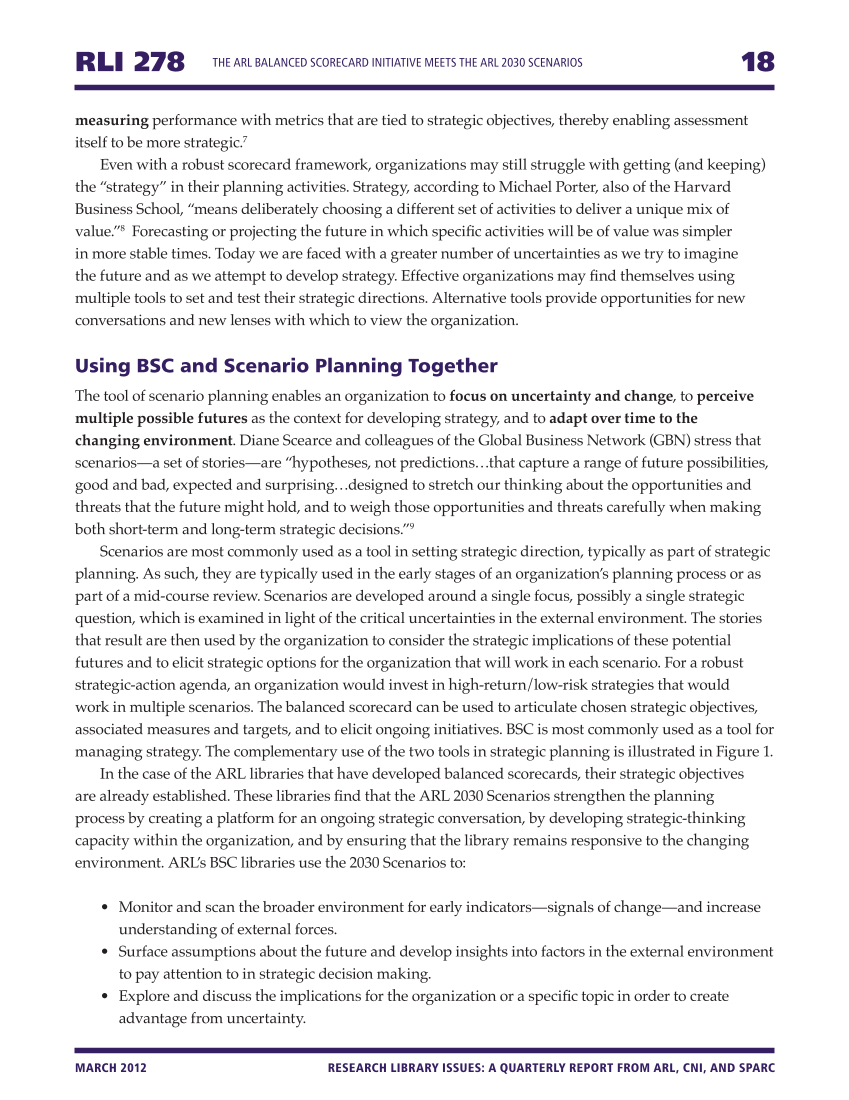RLI 278 18 March 2012R esearch Library Issues: A Quarterly Report from ARL, CNI, and SPARCarc The ARL Balanced Scorecard Initiative Meets the ARL 2030 Scenarios measuring performance with metrics that are tied to strategic objectives, thereby enabling assessment itself to be more strategic.7 Even with a robust scorecard framework, organizations may still struggle with getting (and keeping) the “strategy” in their planning activities. Strategy, according to Michael Porter, also of the Harvard Business School, “means deliberately choosing a different set of activities to deliver a unique mix of value.”8 Forecasting or projecting the future in which specific activities will be of value was simpler in more stable times. Today we are faced with a greater number of uncertainties as we try to imagine the future and as we attempt to develop strategy. Effective organizations may find themselves using multiple tools to set and test their strategic directions. Alternative tools provide opportunities for new conversations and new lenses with which to view the organization. Using BSC and Scenario Planning Together The tool of scenario planning enables an organization to focus on uncertainty and change, to perceive multiple possible futures as the context for developing strategy, and to adapt over time to the changing environment. Diane Scearce and colleagues of the Global Business Network (GBN) stress that scenarios—a set of stories—are “hypotheses, not predictions…that capture a range of future possibilities, good and bad, expected and surprising…designed to stretch our thinking about the opportunities and threats that the future might hold, and to weigh those opportunities and threats carefully when making both short-term and long-term strategic decisions.”9 Scenarios are most commonly used as a tool in setting strategic direction, typically as part of strategic planning. As such, they are typically used in the early stages of an organization’s planning process or as part of a mid-course review. Scenarios are developed around a single focus, possibly a single strategic question, which is examined in light of the critical uncertainties in the external environment. The stories that result are then used by the organization to consider the strategic implications of these potential futures and to elicit strategic options for the organization that will work in each scenario. For a robust strategic-action agenda, an organization would invest in high-return/low-risk strategies that would work in multiple scenarios. The balanced scorecard can be used to articulate chosen strategic objectives, associated measures and targets, and to elicit ongoing initiatives. BSC is most commonly used as a tool for managing strategy. The complementary use of the two tools in strategic planning is illustrated in Figure 1. In the case of the ARL libraries that have developed balanced scorecards, their strategic objectives are already established. These libraries find that the ARL 2030 Scenarios strengthen the planning process by creating a platform for an ongoing strategic conversation, by developing strategic-thinking capacity within the organization, and by ensuring that the library remains responsive to the changing environment. ARL’s BSC libraries use the 2030 Scenarios to: • Monitor and scan the broader environment for early indicators—signals of change—and increase understanding of external forces. • Surface assumptions about the future and develop insights into factors in the external environment to pay attention to in strategic decision making. • Explore and discuss the implications for the organization or a specific topic in order to create advantage from uncertainty.
























